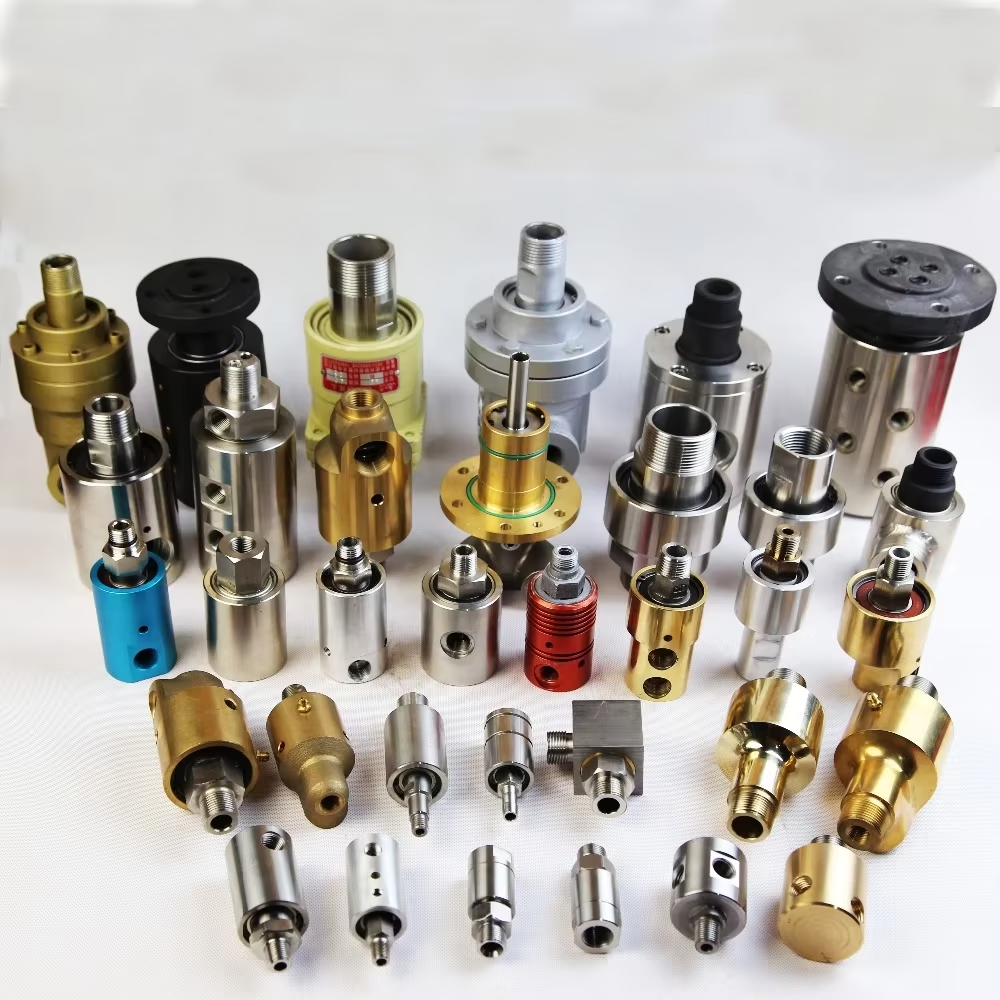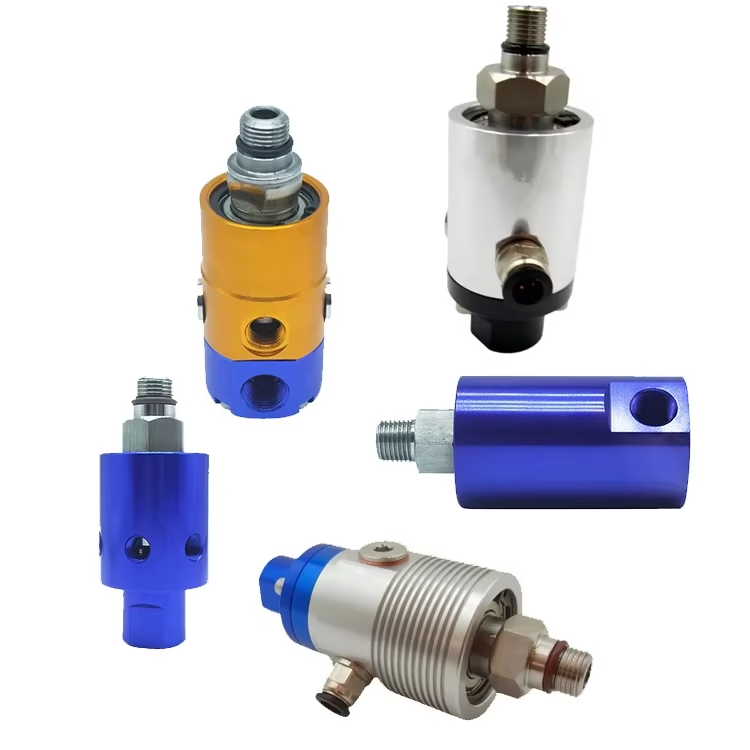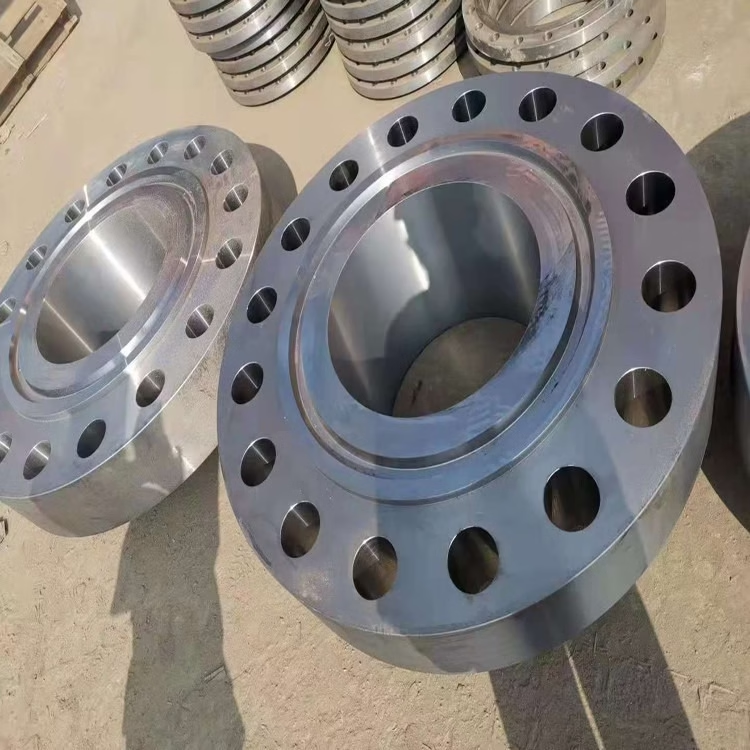The Complete Guide to Deublin Rotary Unions: Types, Uses, and Maintenance Best Practices
Introduction
In the intricate world of industrial machinery and fluid transfer systems, the Deublin rotary unions stand as a crucial yet often overlooked component. For those unfamiliar with the term, you might find yourself asking, “What is a Deublin rotary union?” This blog post aims to demystify this essential device, exploring its definition, working principles, applications, benefits, and much more.
At its core, a Deublin rotary union is a mechanical device engineered to transfer fluids, such as water, oil, steam, or air, between a stationary source and a rotating piece of equipment. The brand “Deublin” has become almost synonymous with high-quality rotary unions, much like how “Kleenex” is associated with tissues. Deublin, founded in 1945, has a long-standing reputation for innovation and reliability in the field of rotary union manufacturing.
How Do Deublin Rotary Unions Work?
The operation of a Deublin rotary union is based on a simple yet ingenious concept. The union consists of two main parts: the stationary housing and the rotating shaft. The stationary housing connects to the source of the fluid, which could be a pipeline, a pump, or a reservoir. On the other hand, the rotating shaft attaches to the moving equipment, such as a rotating drum, a spindle in a machine tool, or a conveyor roller.
Inside the union, some seals and bearings play vital roles in its functionality. The seals prevent fluid leakage between the stationary and rotating components, ensuring a tight and efficient transfer. High-quality seals, often made from materials like carbon, ceramic, or specialized elastomers, are used to withstand high pressures, temperatures, and rotational speeds. The bearings, meanwhile, support the rotating shaft, reducing friction and enabling smooth rotation.
When the rotating equipment starts to move, the Deublin rotary union allows the fluid to flow continuously from the stationary source to the rotating part. For example, in a printing press, where the cylinders are constantly rotating, the rotary union supplies ink or coolant to the cylinders without interrupting the printing process. The union’s design ensures that the fluid can be transferred under various conditions, including high-speed rotation, high-pressure applications, and extreme temperatures.
Applications of Deublin Rotary Unions
Deublin rotary unions find applications in a wide range of industries due to their versatility and reliability.
📄 Papermaking Industry
Application: Drying cylinders, steam balls, coating machines, calenders
Function: Transfers steam, water, and other media for heating, cooling, and lubrication
Example: Drying cylinders use rotary joints to introduce steam for drying and shaping paper.
🧵 Fiber Products Industry
Application: Bleaching machines, mercerizing machines, washing machines, dryers, ironing machines
Function: Transfers water and steam for heating, cleaning, and drying
Example: Mercerizing machines use rotary joints to circulate solutions and process fabrics.
🛢️ Rubber & Plastic Industry
Application: Calenders, extruders, mixers, kneaders, vulcanizers, injection machines, foam machines
Function: Transfers hydraulic oil and cooling water to control temperature and pressure
Example: Internal mixers use rotary joints to stabilize mixing temperature via cooling media.
🖨️ Printing Industry
Application: Rotary offset presses, gravure presses, drying equipment
Function: Transfers ink, steam, and cooling water to control ink supply and equipment temperature
Example: Printing presses rely on rotary joints for ink circulation and roller cooling.
⚗️ Chemical & Pharmaceutical Industries
Application: Dryers, test equipment, ball mills, laminators, crystallizers
Function: Transfers heat transfer oil and chemical solutions for drying, reactions, and separation
Example: Dryers use rotary joints to introduce heat media for efficient material drying.
🔩 Steel & Metal Industries
Application: Continuous casters, straighteners, wire drawing machines, rolling mills
Function: Transfers water and hydraulic oil for cooling, lubrication, and power transmission
Example: Continuous casters use rotary joints to cool crystallizers and ensure ingot quality.
⚡ Electrical Industry
Application: Double water-cooled generators, wire and cable processing machines
Function: Transfers cooling water for heat dissipation and stable operation
Example: Rotary joints ensure rotor cooling water circulation in generators.
🛠️ Machine Tool Industry
Application: CNC machines, drilling machines, stamping machines, injection molding machines
Function: Transfers coolant, lubricating oil, and compressed air for tool cooling, lubrication, and pneumatic control
Example: Machining centers use rotary joints to deliver coolant to spindles for better accuracy.
🍽️ Food Industry
Application: Beverage filling machines, dairy processing equipment, packaging machines
Function: Transfers water and food-grade lubricants, ensuring hygiene and process efficiency
Example: Filling machines use rotary joints for precise liquid filling.
🏥 Medical Equipment
Application: CT machines, surgical lights
Function: Transfers cooling media and signals (including high-definition image and data transmission)
Example: CT machines use rotary joints for stable power and signal transmission to the slip ring.
💻 Semiconductor Industry
Application: Silicon wafer growth, slicing, grinding, polishing, thin-film deposition
Function: Transfers cooling air, water, gases, and electrical signals with high precision
Example: Rotary joints cool high-temperature pull rods and transfer current for film deposition.
🔧 Other Industries
Application: Power generation, petroleum, feed processing, air clutches, gearboxes, automated pneumatic systems
Function: Transfers air, hydraulic oil, and other media for power and control
Example: Used in automated production lines for pneumatic power transmission and system control. Deublin rotary union
Deublin rotary union
Benefits of Using Deublin Rotary Unions
There are numerous advantages to using Deublin rotary unions in industrial applications.
High Reliability
Deublin has a long history of manufacturing high-quality rotary unions. Their products undergo rigorous testing to ensure reliability and durability. The use of premium materials and advanced manufacturing techniques means that these unions can withstand harsh operating conditions, reducing the risk of breakdowns and costly downtime in industrial processes.
Precision and Efficiency
These rotary unions are engineered to provide precise fluid transfer. The accurate design of seals and bearings minimizes fluid leakage and friction, resulting in efficient operation. This efficiency not only saves energy but also improves the overall performance of the connected equipment. For example, in a machining operation, the precise delivery of coolant through a Deublin rotary union can enhance the tool life and the quality of the machined parts.
Versatility
Deublin offers a wide range of rotary unions to suit different applications. Whether you need a union for low-pressure air transfer or high-pressure steam applications, Deublin has a solution. Their unions can handle various fluids, temperatures, and rotational speeds, making them suitable for diverse industries and operating conditions.
Ease of Maintenance
Despite their complex internal design, Deublin rotary unions are relatively easy to maintain. Many models are designed with modular components, allowing for quick and easy replacement of worn-out parts. This modular design reduces maintenance time and costs, as only the specific faulty component needs to be replaced rather than the entire unit.
Types of Deublin Rotary Unions
Deublin manufactures several types of rotary unions to meet the different needs of industries.
Single-Passage Rotary Unions
As the name suggests, single-passage rotary unions are designed to transfer a single fluid. They are commonly used in applications where only one type of fluid, such as air or water, needs to be transferred to the rotating equipment. These unions are relatively simple in design and are suitable for basic fluid transfer requirements.
Multi-Passage Rotary Unions
Multi-passage rotary unions, on the other hand, can transfer multiple fluids simultaneously. For example, in a complex machine tool, it might be necessary to supply coolant, lubricating oil, and compressed air to different parts of the rotating spindle. Multi-passage rotary unions can handle this task, with each passage dedicated to a specific fluid. This type of union requires more precise engineering to ensure that the different fluids do not mix and that each passage functions properly.
High-pressure Rotary Unions
High-pressure rotary unions are built to withstand high-pressure fluid transfer. They are used in applications such as hydraulic presses, where fluids need to be transferred at pressures of several thousand pounds per square inch (psi). These unions feature robust seals and housings to prevent fluid leakage under extreme pressure conditions.
High-Temperature Rotary Unions
For applications involving high temperatures, such as steam-powered equipment or heat-treating processes, high-temperature rotary unions are essential. These unions are constructed using materials that can withstand elevated temperatures without degrading. Special seals and coatings are often used to ensure that the union can operate effectively in high-heat environments.
1116 Series “Closed Seal” Rotary Joint for Coolant Applications
Axial Connection:
1116-048-064 / 1116-048-463 / 1116-485-463 / 1116-580-343 / 1116-600-059 / 1116-600-463 / 1116-610-463
Radial Connection:
1116-090-059 / 1116-090-064 / 1116-090-463 / 1116-516-463 / 1116-555-463
1101 Series “Closed Seal” Rotary Joint for Coolant Applications
Axial Connection:
1101-235-238 / 1101-235-239 / 1101-235-343 / 1101-235-424 / 1101-359-343 / 1101-620-343
Radial Connection:
1101-195-343 / 1101-615-598
1108 Series “Closed Table Seal” Rotary Joint for Coolant Applications
Standard Models:
1108-002-102 / 1108-002-153 / 1108-032-153 / 1108-001-102 / 1108-001-153 / 1108-011-153
High Pressure Models:
1108-019-107 / 1108-019-212 / 1108-034-212 / 1108-058-212
Ultra High Pressure Models:
1108-093-559 / 1108-093-568
1005 Series “Closed Seal” Rotary Joint for Coolant Applications
Radial Connection:
1005-402-401 / 1005-402-448 / 1005-633-401
902 Series “Disconnect” Rotary Joint for Coolant Dry-Running Applications
Axial Connection:
902-111-165 / 902-121-188 / 902-138-188 / 902-141-188
Radial Connection:
902-110-165 / 902-120-188 / 902-137-188 / 902-140-188 / 902-225-101 / 902-225-104 / 902-253-220
1109 Series “Disconnect” Swivel Mount Rotary Joint for Coolant Dry-Running Applications
Standard Models:
1109-011-165 / 1109-021-188 / 1109-041-188 / 1109-010-165 / 1109-020-188 / 1109-040-188
High Pressure Models:
1109-014-196 / 1109-024-212 / 1109-044-212 / 1109-013-196 / 1109-023-212 / 1109-043-212
“Break-away” Hole-Mounted Rotary Joint
Axial Connection:
1109-710-717 / 1109-927-930 / 1109-929-930
Radial Connection:
1109-665-651 / 1109-926-930 / 1109-928-930
7000 / 1115 Series “Controlled Leakage” Rotary Joint for High-Speed Applications
7000 Series – Axial Connection:
7000-003-117 / 7000-003-118 / 7000-003-224 / 7000-003-225
1115 Series – Radial Connection:
1115-114-402 / 1115-114-556 / 1115-680-402 / 1115-680-403
1117 Series Bearingless “Closed Seal” Rotary Joint for Continuous Coolant Applications
Radial Connection:
1117-706 / 1117-711 / 1117-792
Axial Connection:
1117-002-110 / 1117-002-111 / 1117-002-116 / 1117-058-116 / 1117-028-374 / 1117-789 / 1117-490-493 / 1117-063-294
1121 Series Bearingless “Disengagement” Micro-Stroke Rotary Joint for Coolant Applications
Bidirectional Connection:
1121-300-327 / 1121-300-345 / 1121-330-327 / 1121-330-345 / 1121-380-327 / 1121-380-345
Axial Connection:
1121-380-327 / 1121-400-345 / 1121-410-493 / 1121-430-431
1129 Series Bearingless “Disconnect” Coolant Swivel Joint
Two-Way Connection:
1129-033-301 / 1129-033-327 / 1129-050-301 / 1129-859-731
Axial Connection:
1129-016-301 / 1129-036-301 / 1129-036-327 / 1129-039-301 / 1129-730-731 / 1129-927-929 / 1129-052-137
2620 Series Dual-Channel Full-Media Rotary Joint
Choosing the Right Deublin Rotary Unions
Selecting the appropriate Deublin rotary union for your application is crucial for optimal performance and longevity.
Consider the Fluid Type
The first factor to consider is the type of fluid that needs to be transferred. Different fluids have different properties, such as viscosity, chemical composition, and temperature range. For example, if you are transferring a corrosive fluid, you will need a rotary union with seals and housing made from materials resistant to corrosion, like stainless steel or specialized polymers.
Evaluate the Operating Conditions
You also need to assess the operating conditions, including the pressure, temperature, and rotational speed. High-pressure applications require a union with a higher pressure rating, while high-temperature applications demand a union designed to withstand heat. Similarly, high-speed rotation requires a union with high-quality bearings and seals to reduce friction and prevent premature wear.
Determine the Number of Passages
Based on your application’s requirements, decide whether you need a single-passage or multi-passage rotary union. If your equipment needs to transfer only one fluid, a single-passage union will suffice. However, if multiple fluids are involved, a multi-passage union is the better choice.
Look at the Mounting and Connection Options
The mounting and connection options of the rotary union are also important. Ensure that the union can be easily installed on your equipment and that the connections match the existing piping or fittings. Deublin offers a variety of mounting styles and connection types, such as threaded, flanged, or quick-connect, to accommodate different installation requirements.
Installation and Maintenance of Deublin Rotary Unions
Proper installation and maintenance are key to ensuring the long-term performance of Deublin rotary unions.
Installation
During installation, it is essential to follow the manufacturer’s instructions carefully. The union should be mounted securely on the equipment, and all connections should be tightened properly to prevent leaks. Make sure that the rotating shaft of the union is aligned correctly with the rotating part of the equipment to avoid excessive stress on the seals and bearings.
Maintenance
Regular maintenance is necessary to keep the rotary union in good working condition. This includes inspecting the union for signs of leakage, wear, or damage. Seals and bearings should be checked periodically and replaced if they show signs of deterioration. It is also important to keep the union clean and free from debris, as dirt and contaminants can cause premature wear and seal failure. Additionally, lubricating the bearings according to the manufacturer’s recommendations will help ensure smooth rotation and extend the life of the union.
Case of Applications of Deublin Rotary Unions
Automotive Paint Systems (Ford Motor Company)
Ford’s assembly plants utilize Deublin’s 20003-series rotary unions in their electrostatic paint booths. These unions enable uninterrupted paint transfer to rotating spray arms spinning at 800 RPM, maintaining 150 PSI pressure for even coating. The balanced mechanical seals prevent leaks, reducing paint waste by 30% compared to older pressure-seal designs.
Food Processing (Nestlé Dairy Plant)
Nestlé’s UHT milk processing line employs Deublin’s 316L stainless steel rotary unions with FDA-compliant seals. Operating at 300°F, these unions deliver steam and cleaning agents to rotating sterilizer nozzles, ensuring 99.9% bacterial elimination. Their self-lubricating design minimizes downtime, achieving 24/7 operation for six months between maintenance cycles.
Steel Mill Rotary Furnaces (ArcelorMittal)
ArcelorMittal’s 50-ton electric arc furnace uses Deublin’s silicon carbide-sealed unions to circulate cooling water at 1,200°F. The union’s hydrostatic balance system compensates for thermal expansion, preventing bearing failures that previously caused $50,000/week in lost production. This setup withstands 2 RPM rotation under 650 PSI, extending furnace life by 40%.
FAQs About Deublin Rotary Unions
Q1: What industries benefit most from Deublin rotary unions?
Deublin rotary unions are critical in manufacturing (e.g., CNC machinery, printing), renewable energy (wind turbines, solar trackers), aerospace (radar systems, landing gear tests), and medical devices (CT scanners, surgical robots). Their versatility suits any sector requiring reliable fluid/gas transfer during rotation.
Q2: How does Deublin ensure leak-free performance?
Deublin’s proprietary sealed technologies, such as balanced mechanical seals and hydrostatic designs, dynamically adjust to operating conditions, minimizing friction and wear. Materials like tungsten carbide resist corrosion, while rigorous testing ensures compatibility with extreme pressures/temperatures.
Q3: Can Deublin unions handle custom requirements?
Absolutely. Deublin engineers collaborate to design unions with multiple passageways, hazardous-environment certifications, or compact sizes. Their global network also offers rapid prototyping and IoT-enabled “smart” unions for predictive maintenance.
Conclusion
Deublin rotary union is a highly specialized and essential component in many industrial processes. Its ability to transfer fluids between stationary and rotating equipment with high reliability, precision, and versatility makes it indispensable in various industries. By understanding its working principles, applications, benefits, types, and how to choose, install, and maintain it, you can make the most of this remarkable device in your industrial operations. Whether you are in manufacturing, packaging, food and beverage, or the energy industry, Deublin rotary unions can play a vital role in enhancing the efficiency and performance of your equipment.
Although the Deublin rotary joint has many advantages, its price has always been high. The rotary joints produced by our factory to replace Dubolin can almost meet all its index values, but the price is only half that. If you need a high-quality and low-cost rotary joint product, please view our replacement products and contact us.







